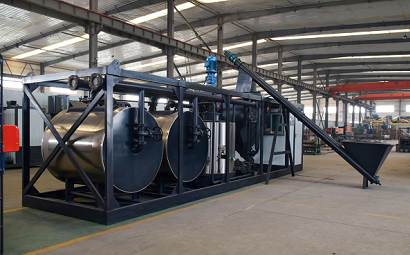How does the emulsified modified asphalt equipment deal with asphalt solidification in winter?
According to the production process, the emulsified modified asphalt equipment can be divided into three types: intermittent emulsified modified asphalt equipment operation, semi-continuous emulsified modified asphalt equipment operation, and continuous emulsified modified asphalt equipment operation. During the production of the emulsified modified asphalt equipment, demulsifier, acid, water, and latex modified materials are mixed in the soap mixing tank, and then pumped to the colloid mill with asphalt. After a tank of soap is used up, it is replenished with soap, and then the production of the next tank is completed.
The emulsified modified asphalt equipment mentioned here includes a hot water pump and a circulating pump. This type of centrifugal water pump generally uses a pipeline centrifugal pump. There is a sewage outlet at the bottom of the pipeline centrifugal pump. Note that it is the sewage outlet at the bottom of the emulsified modified asphalt equipment pump. The water in the water tank is discharged through the filter valve. Some emulsified modified asphalt equipment does not have a filter valve to save equipment costs, so it can only be emptied by loosening the flange anchor bolts at the bottom. There are basically two types of emulsified asphalt equipment moisturizing pumps on the market, gear pumps or centrifugal pumps. Gear pumps can only discharge the liquid in the pump through the connecting flange of the pipeline. Centrifugal pumps treat wastewater through their own sewage outlets.

When used in the production of emulsified asphalt equipment, according to different modification technologies, the latex pipeline can be connected before the colloid mill or after the colloid mill, or there is no latex pipeline, but the required amount of latex is manually added to the soap tank.
Emulsified asphalt equipment generally uses a cone bottom. However, in order to better process the emulsified asphalt equipment coefficient, the inlet and outlet are usually not placed at the bottom. The moisturizing emulsion (mostly water) will remain at the bottom of the tank, and this part of the residual liquid needs to be discharged through the filter valve at the bottom. Both hot and cold substances in the heat exchanger of the emulsified asphalt equipment need to be discharged.
There will be residual emulsion or water in the colloid mill. The gap between the stator and rotor of the colloid mill is within 1mm. If there is a little residual water in the emulsified modified asphalt equipment, it will cause the frostbite emulsified modified asphalt equipment accident. The residue in the colloid mill can be treated by loosening the finished product pipeline connection bolts. The valve body of many emulsified modified asphalt equipment adopts pneumatic type, and there will be a pump component. The water content in the air will become water stored in the tank after expansion. This part of water should be released in winter.
When draining water or moisturizing emulsion pipelines of emulsified modified asphalt equipment, the ball valve should be in the open state. If there is water in the emulsified modified asphalt equipment during operation or the vacuum pump is caused by the valve being closed, the liquid in the pump and pipeline is not discharged, which will cause the frostbite emulsified modified asphalt equipment accident. The cooling circulating water of the colloid mill, many colloid mills use mechanical seals, which will use cooling circulating water. This part of cooling circulating water should be released. Other areas where water may exist. The high-temperature heat transfer oil pipeline of the emulsified modified asphalt equipment is not easy to condense in winter and does not need to be emptied. The emulsified modified asphalt equipment will condense in winter, but the volume is not easy to increase during the condensation process and does not need to be emptied.
 Albanian
Albanian  Russian
Russian  Arabic
Arabic  Amharic
Amharic  Azerbaijani
Azerbaijani  Irish
Irish  Estonian
Estonian  Odia (Oriya)
Odia (Oriya)  Basque
Basque  Belarusian
Belarusian  Bulgarian
Bulgarian  Icelandic
Icelandic  Polish
Polish  Bosnian
Bosnian  Persian
Persian  Afrikaans
Afrikaans  Tatar
Tatar  Danish
Danish  German
German  French
French  Filipino
Filipino  Finnish
Finnish  Frisian
Frisian  Khmer
Khmer  Georgian
Georgian  Gujarati
Gujarati  Kazakh
Kazakh  Haitian Creole
Haitian Creole  Korean
Korean  Hausa
Hausa  Dutch
Dutch  Kyrgyz
Kyrgyz  Galician
Galician  Catalan
Catalan  Czech
Czech  Kannada
Kannada  Corsican
Corsican  Croatian
Croatian  Kurdish (Kurmanji)
Kurdish (Kurmanji)  Latin
Latin  Latvian
Latvian  Lao
Lao  Lithuanian
Lithuanian  Luxembourgish
Luxembourgish  Kinyarwanda
Kinyarwanda  Romanian
Romanian  Malagasy
Malagasy  Maltese
Maltese  Marathi
Marathi  Malayalam
Malayalam  Malay
Malay  Macedonian
Macedonian  Maori
Maori  Mongolian
Mongolian  Bengali
Bengali  Myanmar (Burmese)
Myanmar (Burmese)  Hmong
Hmong  Xhosa
Xhosa  Zulu
Zulu  Nepali
Nepali  Norwegian
Norwegian  Punjabi
Punjabi  Portuguese
Portuguese  Pashto
Pashto  Chichewa
Chichewa  Japanese
Japanese  Swedish
Swedish  Samoan
Samoan  Serbian
Serbian  Sesotho
Sesotho  Sinhala
Sinhala  Esperanto
Esperanto  Slovak
Slovak  Slovenian
Slovenian  Swahili
Swahili  Scots Gaelic
Scots Gaelic  Cebuano
Cebuano  Somali
Somali  Tajik
Tajik  Telugu
Telugu  Tamil
Tamil  Thai
Thai  Turkish
Turkish  Turkmen
Turkmen  Welsh
Welsh  Uyghur
Uyghur  Urdu
Urdu  Ukrainian
Ukrainian  Uzbek
Uzbek  Spanish
Spanish  Hebrew
Hebrew  Greek
Greek  Hawaiian
Hawaiian  Sindhi
Sindhi  Hungarian
Hungarian  Shona
Shona  Armenian
Armenian  Igbo
Igbo  Italian
Italian  Yiddish
Yiddish  Hindi
Hindi  Sundanese
Sundanese  Indonesian
Indonesian  Javanese
Javanese  Yoruba
Yoruba  Vietnamese
Vietnamese  Hebrew
Hebrew  Chinese (Simplified)
Chinese (Simplified)






